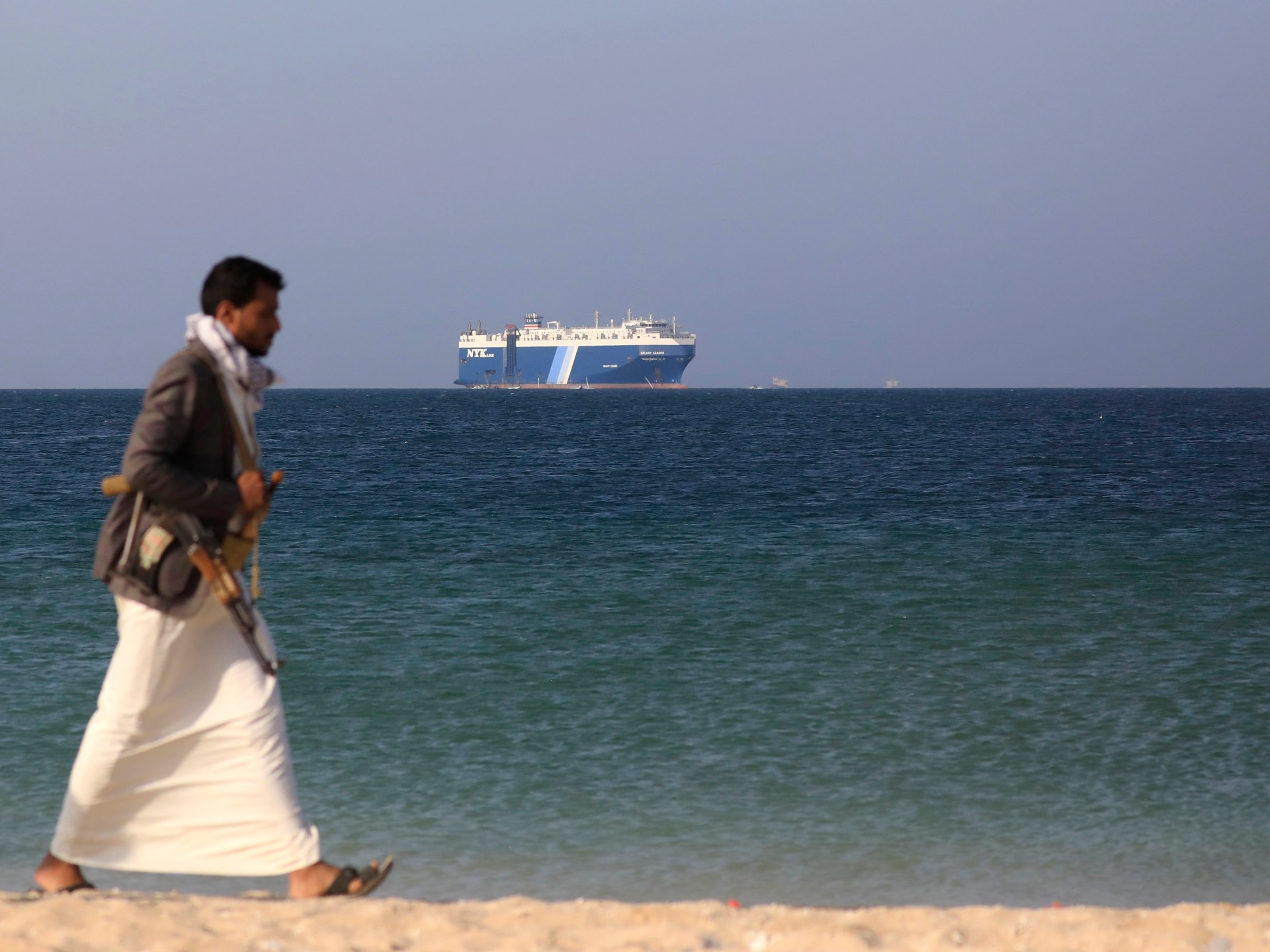Myanmar’s ‘reluctant’ resistance fighter
Listen to this story:
Khun Nan Nan felt a sense of relief as the cadets finished an exhausting day of training. Dozens of men, dressed in green and black army fatigues, were spread out across a large dirt field deep in the foothills of eastern Myanmar’s Kayah State (also called Karenni State). The cadets were training to join an elite group of the Karenni Nationalities Defence Force (KNDF), an ethnic armed organisation (EAO) fighting the Myanmar military.
As dusk approached and the sky turned orange, some of the young men completed push-ups, while others finished a round of boxing and another group cleaned their rifles. In every direction, there were mountains thick with forests.
Twenty-six-year-old Khun had been tasked with protecting the commander of KNDF Brigade 5, a man he grew up with but cannot name for security reasons. As the commander oversaw the training from the side of the field, Khun, with a rifle in his hand, watched over him.
Then suddenly from above, came the sound of a low flying military jet. The cadets looked up at the sky in dismay.
“Get into positions!” one of the trainers shouted. In an instant, the men ran to the relative cover offered by the nearby trees. There, they froze, motionless as the jet continued to fly overhead.
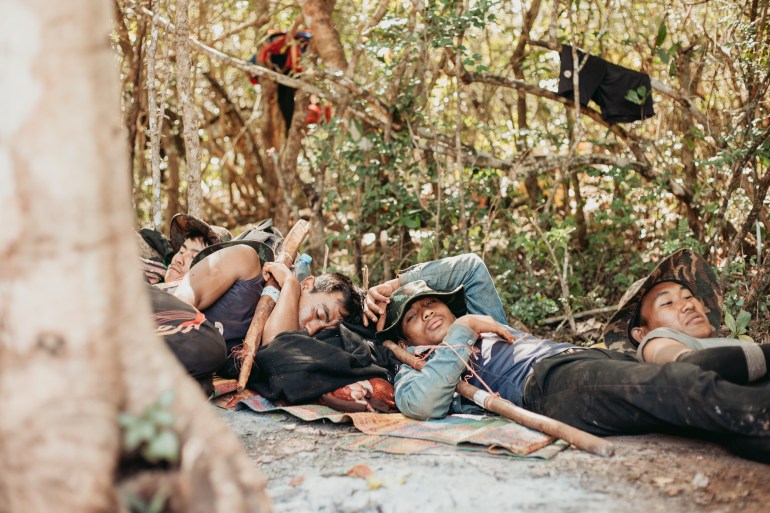 A group of resistance fighters take a break between training sessions in eastern Myanmar’s Kayah State. The men have joined the People’s Defence Forces (PDF) to defend themselves and their communities. They hope to eventually overthrow the Myanmar military [Lin Let Akar/Al Jazeera]
A group of resistance fighters take a break between training sessions in eastern Myanmar’s Kayah State. The men have joined the People’s Defence Forces (PDF) to defend themselves and their communities. They hope to eventually overthrow the Myanmar military [Lin Let Akar/Al Jazeera]For almost a year, KNDF has been fighting to take back control of Kayah’s cities, townships, and villages from Myanmar’s military. Khun says that although the majority of the state has been “liberated”, the military still seeks the fighters out from the air, using helicopters and fighter jets to bomb their suspected locations.
Some of the men described the jets that appear suddenly as being like “demons” or “asteroids”. Their fear of them is made worse by the realisation that they cannot defend themselves against them – they simply do not have the weapons capability to return fire.
This time the men were spared. The jet changed its path and the roar of its engine faded as it disappeared into the distance. But Khun said such moments take a toll.
“It’s exhausting because I never feel safe anywhere I go,” he said solemnly. “We no longer feel safe in our own homeland.”
‘Inflicting pain’
For decades, conflict has raged between Myanmar’s armed forces, or Tatmadaw, and a multitude of ethnic armed groups who desire independence from a regime that has long violently oppressed them.
That violence has increased since the military overthrew the democratically elected National League for Democracy (NLD), a political party led by Nobel prize winner Aung San Suu Kyi on February 1, 2021. Before the coup, Myanmar’s ethnic armed groups had not worked together in meaningful ways, but that is slowly changing.
 Last May, Myanmar’s shadow government formed its armed wing, known as the People’s Defence Force (PDF). These smaller groups of fighters now make up much of the nationwide resistance to the military [Lin Let Akar/Al Jazeera]
Last May, Myanmar’s shadow government formed its armed wing, known as the People’s Defence Force (PDF). These smaller groups of fighters now make up much of the nationwide resistance to the military [Lin Let Akar/Al Jazeera]Today, the resistance is more complex than individual groups separately fighting for independence. Many ethnic groups under the National Unity Government (NUG), Myanmar’s shadow government consisting of elected members of parliament who have gone into exile, are calling for the Tatmadaw to be dissolved and replaced with a new armed force that is not controlled by the Burman ethnic majority. The NUG wants to establish a “federal army”, under civilian control, with members of different ethnic groups free to operate without the Tatmadaw’s institutional system of violence against their own people.
Last May, the NUG formed its armed wing, known as the People’s Defence Force (PDF). These smaller groups of fighters now make up much of the nationwide resistance to the military.
The NUG claimed that PDFs have killed more than 1,000 Tatmadaw soldiers. Some analysts have said KNDF is one of the most effective of the PDFs at combating the country’s military regime, as they claim to have killed hundreds of troops when pushing the military out of Kayah State.
But the air raids have been taking a psychological toll on the fighters and some of the men were already beginning to show signs of post-traumatic stress disorder (PTSD).
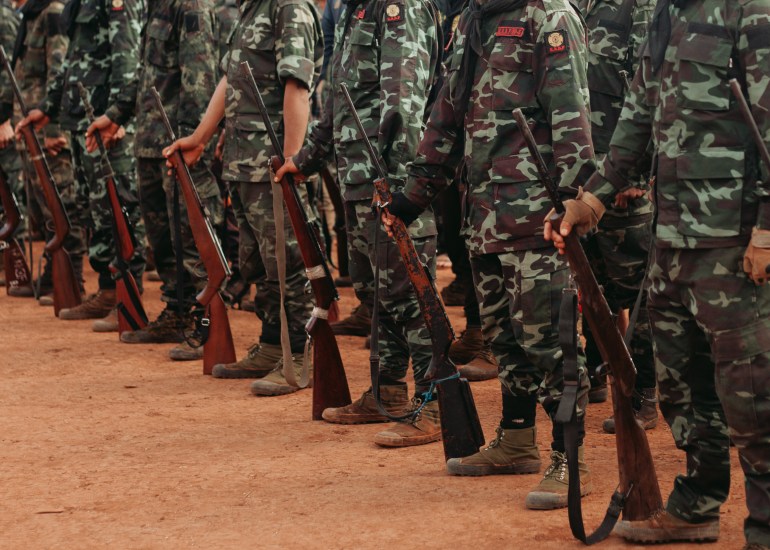 The cadets stand at attention at a graduation ceremony [Lin Let Akar/Al Jazeera]
The cadets stand at attention at a graduation ceremony [Lin Let Akar/Al Jazeera]“Every day, planes fly over our heads,” Khun said. “We are startled even when we hear the sound of a car or motorcycle engine backfiring. Our minds believe a fighter jet is approaching us.”
But the Tatmadaw planes were not only targeting rebels training in the country’s mountains. Human rights groups have documented deliberate attacks on civilians, including fleeing displaced people. They said these attacks amount to war crimes.
“The military is even dropping bombs on refugee camps,” Khun said. “They have set fire to people’s houses and communities. But still, they are not content. Now they use jet planes and helicopters to inflict even more pain on us.”
‘Not just a comrade’
Like thousands of other civilians, Khun took up arms against the military in the wake of last year’s coup. Throughout Myanmar, people like him have been preparing for all-out war, training in the borderlands, and arming themselves with anything from hunting rifles to handmade guns and explosives.
For Khun, the prospect of violence has become a fixture of daily life. It is part of his new calling, his reluctant mission. He says he doesn’t want to be a soldier, no one training in the hills does – but in war-torn Myanmar, they have no choice.
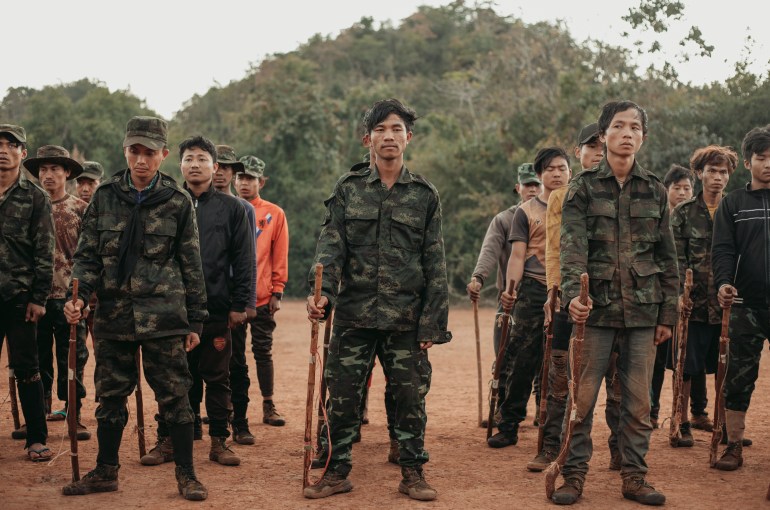 Most of the trainees in Kayah State are reluctant fighters. They lack basic military equipment, holding wooden sticks to imitate rifles while they wait for more arms support [Lin Let Akar/Al Jazeera]
Most of the trainees in Kayah State are reluctant fighters. They lack basic military equipment, holding wooden sticks to imitate rifles while they wait for more arms support [Lin Let Akar/Al Jazeera]Khun is more interested in DSLR cameras than assault rifles. Just a year ago, the athletically built young man with a wide smile and gentle demeanour was a budding wedding photographer, capturing happy couples in their traditional red Karenni outfits.
Growing up in rural Kayah, he always had an interest in gadgets, computers and technology, but had little access to them. His family were farmers and each day he and his siblings would help around the farm as their father worked in the fields and took care of the livestock. But even then, his parents would whisper about the Tatmadaw.
“It was not peaceful even when we were children … The military soldiers would come to our villages and sleep in our homes, eat our food, take our livestock. We were scared back then, as well.”
But he said it was nothing like it is now.
It was only after the military toppled the short-lived democratic government that Khun contemplated joining the resistance.
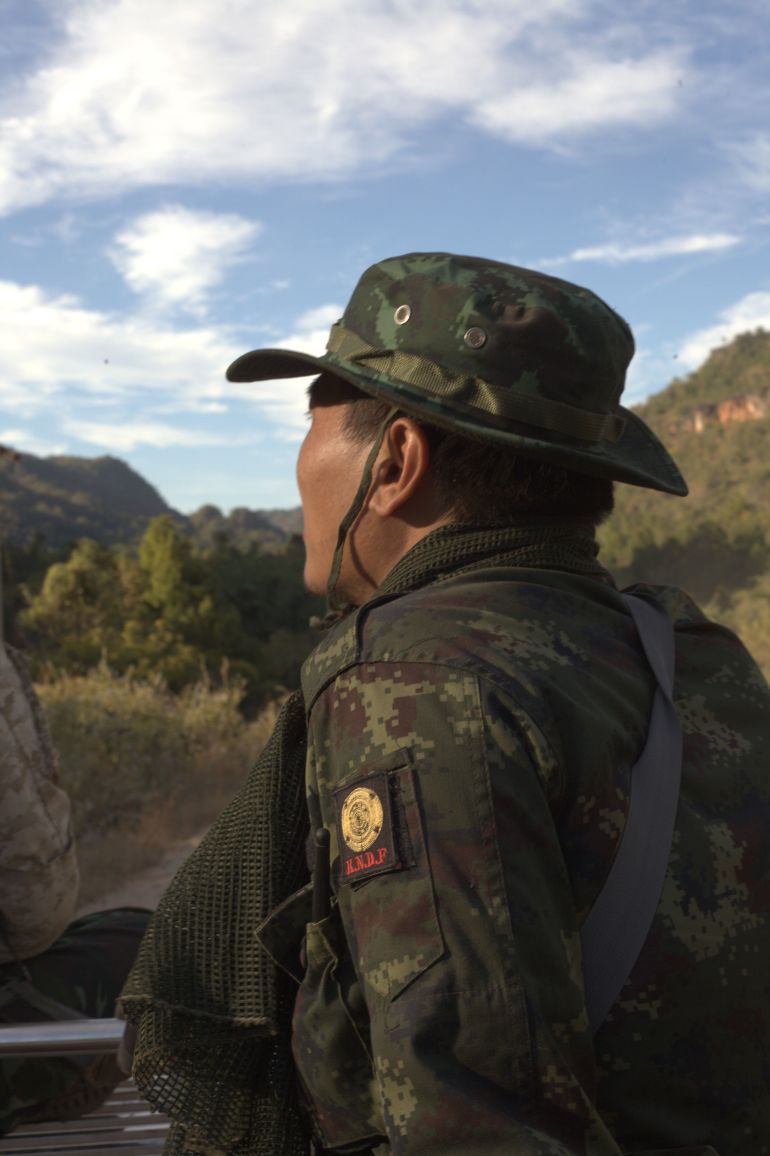 Khun Nan Nan’s training lasted a few weeks and soon after, his officers promoted him to become the personal bodyguard for the brigade’s top commander [Lin Let Akar/Al Jazeera]
Khun Nan Nan’s training lasted a few weeks and soon after, his officers promoted him to become the personal bodyguard for the brigade’s top commander [Lin Let Akar/Al Jazeera]At first, he was part of underground cells fighting in urban centres. But as his comrades were arrested and tortured during interrogations, everything changed. The troops “began slaughtering everyone”, Khun said. It was these acts of brutality that compelled him to join the KNDF.
“I joined the resistance because I could no longer tolerate the military regime,” he said. “Just like everywhere in the country, the military crackdown was very intense. There was a lot of tear gas during the first protests. But then they started shooting with live rounds and we had to run.”
When, early one morning last February, Khun woke to the news that anti-coup protesters had been shot in the streets and images of dead civilians began saturating his social media feeds, it became glaringly clear to him that taking up arms was his only option.
“It was clear for us,” he said. “We voted, then we protested peacefully for our freedom. But they don’t care about what the people want. So now we have to physically fight for our freedom.”
His training lasted a few weeks and soon after, his officers promoted him to become the personal bodyguard for the brigade’s top commander.
But Khun does not seem like a hardened warrior. His comrades described him as calm, measured, “a monk” with a rifle, they said. Before the coup, he enjoyed watching movies, listening to music, and spending time with friends. But since the uprising, all of his energy and time has gone into the resistance.
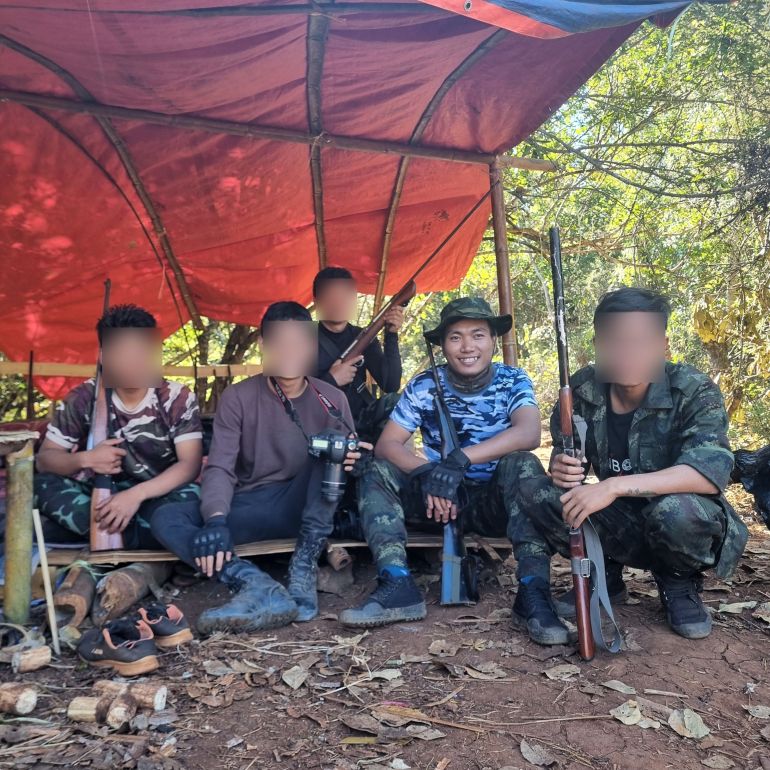 Khun Nan Nan with fellow fighters [Lin Let Akar/Al Jazeera]
Khun Nan Nan with fellow fighters [Lin Let Akar/Al Jazeera]Many of the younger recruits, aged in their late teens or early 20s, consider him an almost brother-like figure. Alone and away from their families, the cadets have built a deep sense of camaraderie, and Khun is a leader in their eyes.
He “is honest, kind and very energetic,” said one KNDF fighter who trained with Khun but asked not to be named. “He’s always been like this since we were kids. Not just a good comrade, but a good friend.”
One of Khun’s responsibilities was to guide and protect the young cadets. Whenever the tension of the day peaks, he was the first to crack a joke to help calm the agitated young men. He sat with them during meals, taking time to get to know them personally and to offer emotional support.
The other fighters admired him for his commitment to the new recruits, but Khun said his real commitment is to his Christian faith. Nothing that he does can be accomplished without God, he said. Every night, he prays for the Tatmadaw’s downfall.
Displaced but not alone
According to the Assistance Association for Political Prisoners, a non-profit organisation that advocates for political prisoners in Myanmar, the military has killed at least 1,500 men, women and children since the coup and detained almost 10,000 others.
One of the most brutal attacks took place on a highway on Christmas eve, when at least 35 civilians were murdered as they fled Kayah. The military reportedly set fire to them inside their vehicles. Among the victims were women and children. Many had been gagged, had their hands tied behind their backs and had holes in their lungs and chests. The massacre was one dark story amid a year of unspeakable violence.
But it was the air raids, just like those that have put fear into the hearts of Khun and the other recruits, that have really underlined the inequity to this conflict. The air attacks have destroyed countless homes, reportedly killed dozens of people, and created a humanitarian crisis at the Thai-Myanmar border.
 A group of cadets listen to instructions from one of the leading commanders at their base. The men are preparing for all-out civil war, using hunting rifles, homemade guns, and small explosives [Lin Let Akar/Al Jazeera]
A group of cadets listen to instructions from one of the leading commanders at their base. The men are preparing for all-out civil war, using hunting rifles, homemade guns, and small explosives [Lin Let Akar/Al Jazeera]Thousands of refugees fleeing these attacks have made their way to KNDF-controlled territory.
One evening in December, hundreds of displaced people walked into Khun’s base asking for refuge.
It was dark and cold but Khun helped them make fires around which they could huddle for warmth. He handed out food and water and did what he could to make them feel at home.
“We’re here because the military started bombing our homes,” one of the displaced people explained as her four young children played in the background.
She had first fled her village in eastern Kayah State four months earlier when the Tatmadaw raided it. She walked through rough mountainous terrain, eventually reaching an informal settlement where she stayed for two months. Then she returned home but found the village devastated, like a ghost town.
“The night I went back home, I heard gunshots and I couldn’t sleep,” she said. “So the next day, I left.”
She made her way back to the settlement, but when the people there started running out of water, some of them decided to embark on the dangerous trek to Khun’s base. They hoped to find refuge and security there.
“We don’t have a home any more,” the woman explained. “We have to keep moving around, and it’s very cold. We’re thankful to the people helping us.”
Her family is one of the hundreds of thousands that have fled.
“It’s not safe for them to go back home, because the Tatmadaw have laid down landmines near their homes and the fighting could resume at any time,” Khun explained.
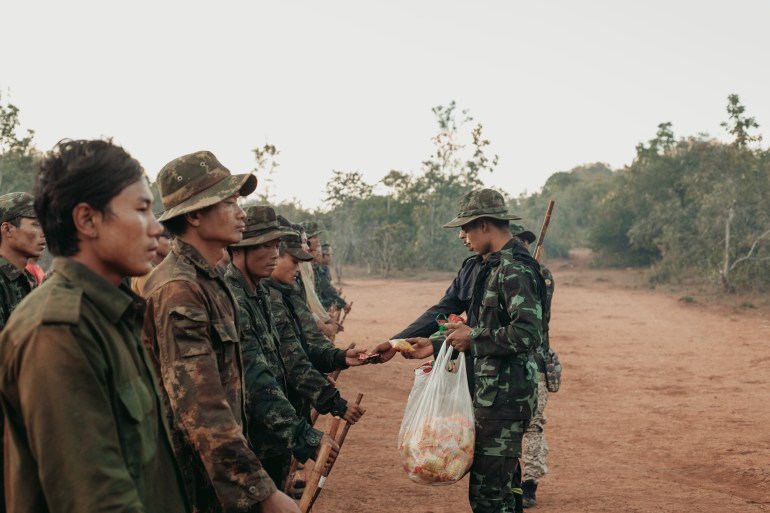 KNDF cadets receive small packages of food before embarking on a training mission [Lin Let Akar/Al Jazeera]
KNDF cadets receive small packages of food before embarking on a training mission [Lin Let Akar/Al Jazeera]Khun and the cadets helped build makeshift shelters for the displaced people out of bamboo, wood, and tarpaulin.
“The IDPs (internally displaced people) showed up unexpectedly,” Khun said with a smile, his eyebrows raised as he explained that they have little food to share with them. “But we can’t reject them, we joined the resistance forces to protect our people, so we have to accept them.”
‘The military will fall’
At night, Khun slept under the stars in a makeshift bamboo shelter. His rifle was always within arm’s reach. The nights were cold, and even with multiple layers of clothes, the young men shivered in the darkness. They were also hungry – they barely had enough food for two small meals a day, many of which consisted only of rice and chillies.
These young men would rather not have to fight. Staring down Myanmar’s military is not easy. But some analysts and commentators felt that the tide is slowly turning; that the Tatmadaw’s 250,000 troops are overstretched by forces like KNDF and that defections are on the rise.
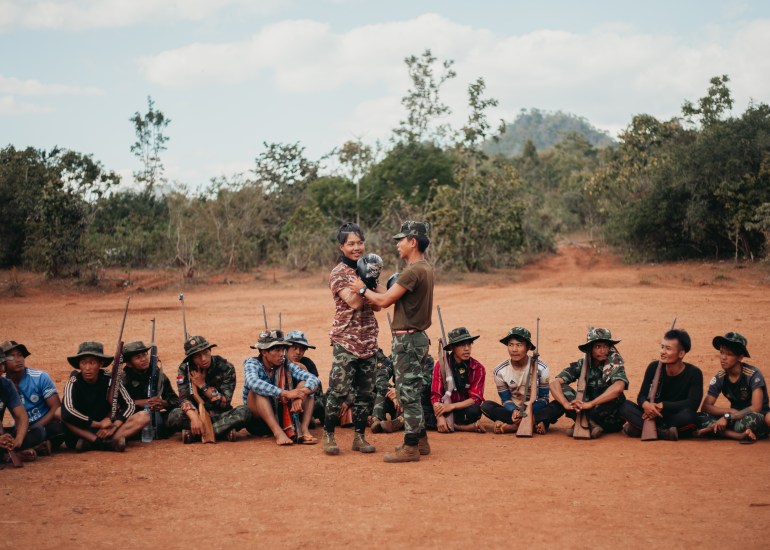 The cadets train in boxing and hand-to-hand combat. The vast majority of the men do not have military experience and are learning the basics of how to defend themselves [Lin Let Akar/Al Jazeera]
The cadets train in boxing and hand-to-hand combat. The vast majority of the men do not have military experience and are learning the basics of how to defend themselves [Lin Let Akar/Al Jazeera]Khun believed now is the time for all those resisting across Myanmar to come together. It is true, they didn’t have enough weapons or ammunition, that they were suffering from a lack of funding and resources, but he was hopeful that if the country’s armed ethnic groups work under one banner, they could overthrow the military and eventually build a new federal government.
“We need a lot of support from the people and the NUG,” he said. “[But] if we have enough resources, the military will not be in charge any more. And once the ethnic armed groups come together, the military will fall.”

